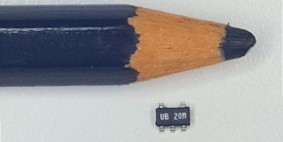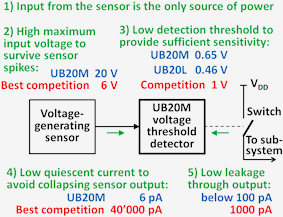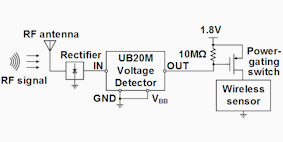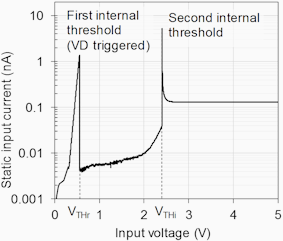High-bandwidth current sensing
Making visible high-frequency features in the current of SiC and GaN converters, through noise-immune field sensors.

Fig. 1: UB20M voltage detector IC
UB20M voltage detector IC
The new UB20M voltage detector IC in Fig. 1 enables zero-power sensing and listening. It allows circuit designers to eliminate standby power, to develop circuits that perform continuous monitoring without using battery power, and to implement wireless wake-up with zero receive power. The device is a sensor-driven circuit that requires no power supply, instead it uses power from a sensor signal to wake up. Suitable sensors are wireless antennas, infrared diodes, piezoelectric accelerometers, and other voltage-generating sensors.

Fig. 2: Sensor-driven wake-up concept, and its electrical requirements.
A sensor circuit is used to generate a small voltage, 650 mV is sufficient, and the voltage detector is then able to trigger an open-drain output, which activates a switch, as illustrated in Fig. 2. This allows the powering up of sub-systems. The voltage detector meets five criteria which allow it to be sensor-driven, see Fig. 2. Its input is rugged and survives 20 V without using traditional protection circuits that would clamp the signal, and thereby affect the data or power in the signal. The threshold is low at 0.65 V, to provide sufficient sensitivity (we also have lower threshold variants). The sensor uses only a few pA from the sensor, thereby permitting the use of conventional sensors, rather than more powerful and bulky energy harvesters. The detector is suitable for input signals with input voltage gradients from 0 to 10V/ms. At gradients higher than 10V/ms, the threshold increases. Detection hysteresis prevents output oscillations.

Fig. 3: Demonstration of an infrared receiver that consumes no power
Infrared (IR) receiver that consumes zero power in standby
We have demonstrated, using the UB20M voltage detector, an IR receiver circuit that uses no power during listening, see our video demonstration. This could be applied to TVs or any IR remote control or triggering mechanism. The extremely low quiescent current of the detector of 5.4 pA (at 1 V), allows the detector to be powered up from photodiodes that are illuminated by an infrared TV remote controller. In the demo we have added a receiver circuit containing these photodiodes, and a UB20M detector that activates a power gating switch, in a TV's 12V supply, in order to cut off the receiver's standby power.

Fig. 4: Example application - RF signal detection and wake-up by radio
Sensor-driven electronics
The UB20M voltage detector makes continuous sensing possible without use of a power source. Its power requirements are a few picowatts, and therefore conventional voltage-generating sensors, such as photodiodes, piezoelectric accelerometers, acoustic sensors, and RF receiving antennas can power the device up. In this way, the sensor is continuously monitored, using power from its own output signal, without drawing power from batteries or the mains. There is a small leakage current of below 100pA through the open-drain output. The extremely low quiescent current (5.4 pA) of the detector ensures that the loading of sensors is minimal, which leaves the sensor output intact for other tasks, such as analogue sensing or energy harvesting. Please see our videos on zero-power sensing.

Fig. 5: Measured input current against input voltage of the UB20M voltage detector
Measured electrical characteristics of the UB20M voltage detector
Fig. 5 shows the input current of the voltage detector to be below 10 pA while the sensor is being monitored. Once the sensor output reaches the detector threshold of 0.5 V, the input current rises temporarily to just over 1 nA, returning back to below 10 pA once the detector has triggered. At 2.4 V there is another jump to just above 100 pA. A full datasheet is available here: UB20M datasheet (PDF, 361kB).
